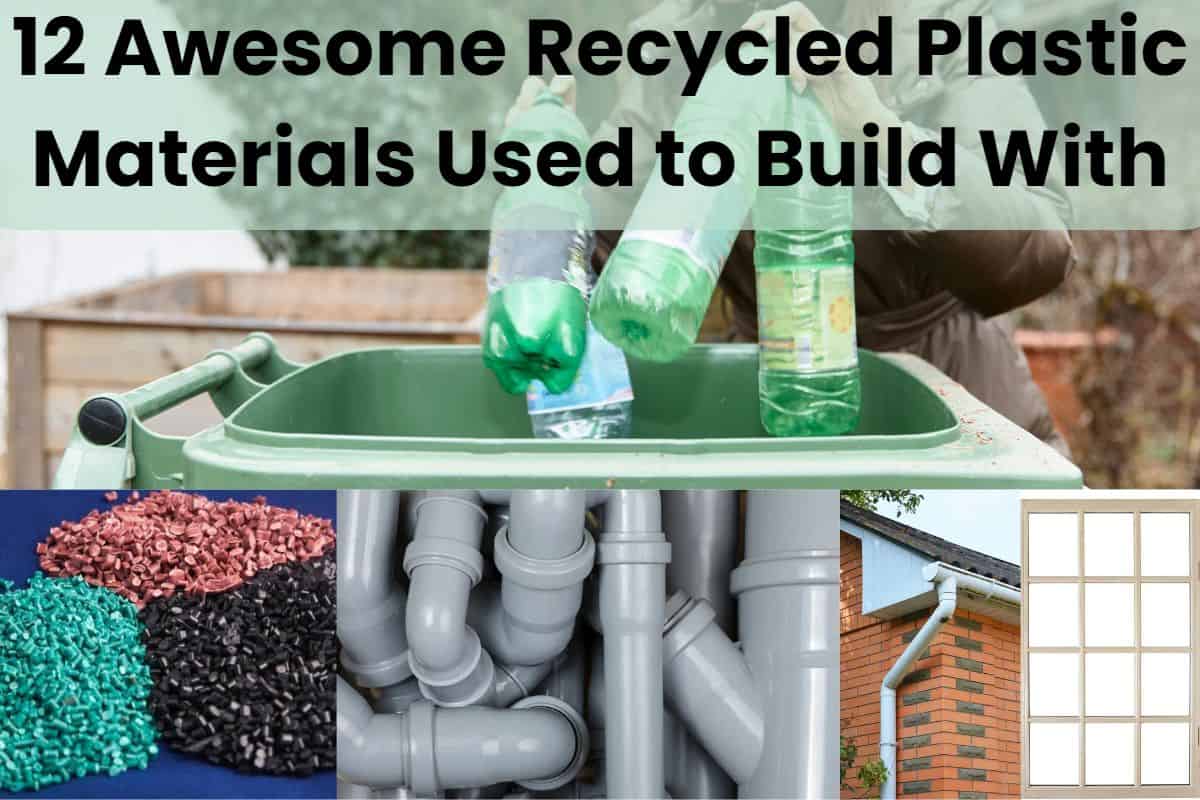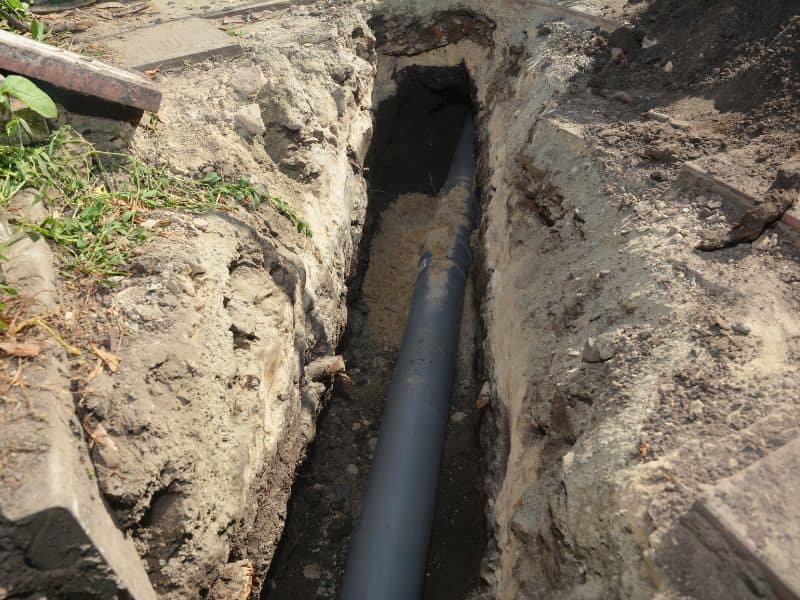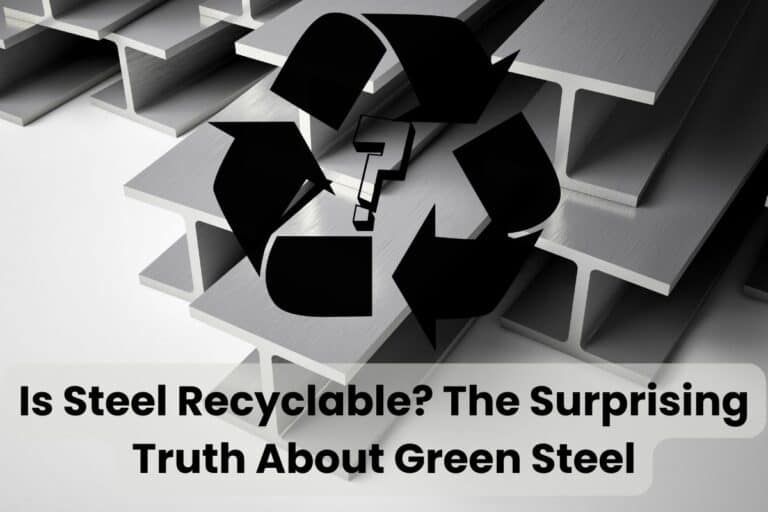12 Awesome Recycled Plastic Materials Used to Build With

When it comes to building and construction, plastic materials are often considered a short-term solution – something that’s not as sturdy or reliable as steel and concrete.
However, what if I told you that there are ways to make recycled plastics into a sturdy and reliable construction material?
Recycling and reusing plastic in construction is an excellent way to reduce the more than 8 million tons of plastic that get into our oceans annually.
It is a sustainable building material and a great way to give new life to materials that would otherwise be headed for the landfill.
Additionally, recycled plastic building and construction materials are often cheaper than traditional options like steel or concrete. It’s a win-win!
In the rest of this article, I’ll discuss 12 excellent recycled plastic materials used for building.
You’ll learn about the different parts of a house you can build with recycled plastic materials.
Let’s get started!
1. High-Density Polyethylene (HDPE)

HDPE is a thermoplastic polymer made from petroleum.
It is the most common recycled plastic material in construction projects due to its excellent tensile strength. With a tensile strength of 4,000 pounds per square inch (psi), it’s ideal for making strong plastic components that can withstand stress and pressure.
Moreover, this material has an outstanding strength-to-density ratio, meaning it’s light enough for easy handling yet strong enough for various building applications.
The above features are the reasons HDPE is used for making:
- Recycled plastic lumber
- Planks
- Panels
- Snowboards
- Cutting boards
- Pipes
Since HDPE is also resistant to water, you can use it for outdoor structures like playgrounds, fences, decking, landscaping, and outdoor furniture.
2. Polyvinyl Chloride (PVC)

PVC is an excellent construction material for a good reason; it’s resistant to abrasion, lightweight, and possesses superior mechanical strength and toughness.
As a thermoplastic polymer made from petroleum, PVC will not corrode or rot. It’s often used in the following building applications:
- Making pipes and fittings for plumbing systems
- Window frames
- Electrical conduits
- Wall panels
- Roofing membranes
- Rain gutters
- Insulation boards
- Flooring tiles
- Corrugated sheeting
Many companies prefer PVC because it is relatively inexpensive, easy to install, and has a long lifespan.
3. Low-Density Polyethylene (LDPE)

The main difference between LDPE and HDPE is that the former is a branched version of polyethylene while the latter is linear. The branched nature makes LDPE less dense than HDPE.
The low-density nature of LDPE doesn’t make it less strong. It has a tensile strength of 1,400 psi with a flexural modulus of 30,000 psi.
That said, LDPE is an excellent construction material because it’s chemical resistant, flexible, lightweight, strong enough to resist impacts, and can be easily molded into various shapes.
Due to its features, it can be used for making:
- Cable covers
- Pipes and fittings
- Flexible sheeting
- Insulation boards
- Floor coverings
- Decking boards
- Gutter systems
4. Polypropylene (PP)

Also known as polypropene, polypropylene is a thermoplastic polymer made from petroleum. It’s often used for making construction materials because of its numerous advantages.
An astounding feature of PP is its high melting point of 160°C (320°F). Consequently, it’s ideal for high-temperature applications like making kitchenware and electrical insulation materials.
Additionally, PP has a low thermal conductivity, making it an excellent material for building insulation boards.
The lightweight and chemical resistance nature of PP makes it suitable for making:
- Furniture
- Storage tanks
- Pipes and fittings
- Guttering systems
- Paneling
- Filtration membranes
- Industrial containers
5. Polystyrene (PS)

Polystyrene is another fantastic recycled plastic material you can build with. It’s primarily used in the production of polystyrene foams, commonly known as styrofoam.
These foams have a high insulating capacity and can be used for making building insulation boards.
In the recycling process, PS is made with 95% air. Therefore, the material has low thermal conductivity, making it suitable for insulation. Consequently, styrofoam is ideal for keeping buildings cool in summer and warm in winter.
The transportation industry uses this recycled plastic as a backfill for roads, bridges, and embankments.
6. Nylon (PA)

Nylon, also known as polyamide, has excellent mechanical properties, including:
- High tensile strength
- Excellent elasticity
- Good chemical resistance
- Impact resistance
These features make nylon ideal for making pipes, fittings, panels, sheets, plumbing fittings, safety nets, bolts, and screws.
The low coefficient of friction in nylon makes it suitable for applications that involve sliding and rotation, like building joints.
Finally, since nylon is waterproof and fast-drying, it suits outdoor furniture and tent lining.
7. Polycarbonate (PC)

The only difference between polycarbonate (PC) and other plastics is the presence of carbonates in polycarbonates. These carbonates make it stronger and rougher for use in building projects.
PC is a high-performing thermoplastic suitable for the following applications:
- As a glass replacement in windows and skylights
- An exterior element for LED lighting
- Security glazing to strengthen guard booths, convenience stores, bank teller shields, prisons, and hurricane shutters
- Sports stadium roofs to protect fans from the elements while allowing sufficient light to enter
8. Acrylonitrile Butadiene Styrene (ABS)

ABS is an amorphous thermoplastic terpolymer used in various construction projects. It’s made from acrylonitrile, butadiene, and styrene, hence the name.
This type of plastic is preferred for structural applications like resistance to impact, stress and abrasion, and high rigidity.
Since this plastic has high dimensional stability, it’s used in making electrical enclosures, intricate components and hardware, bumpers, housings, protective covers, frames, and grids.
Its high corrosion resistance explains why it’s used to make drainage systems, bathroom wall panels, boilers, and sewers.
It’s also used to make interior door linings and lightweight containers.
9. Polyethylene Terephthalate (PET)

PET is mostly used with glass fiber for engineering resins in construction.
Engineers usually use polyethylene terephthalate in concrete as a structural element. PET aggregates create high-quality mixtures with low volumetric weight.
However, the mixtures have excellent mechanical properties similar to those of concrete. Therefore, PET reduces weight per unit volume to make the aggregate lightweight for construction purposes.
PET-based aggregates are primarily used in the erection of reinforced concrete floors and rehabilitation.
10. Thermoplastic Olefin (TPO)

Thermoplastic Olefin is a more rigid and durable recycled material ideal for building.
It’s primarily used in making construction membranes for:
- Roofing purposes
- Waterproofing basements, decks, and walls
Designed for low maintenance and long-term durability, TPO is also used to make siding panels, skylights, and cladding. In addition, the plastic is moisture-resistant, making it suitable for long-term outdoor use.
Due to its excellent abrasion resistance, TPO is also used to make window frames and railings.
11. Thermoplastic Elastomer (TPE)

TPE is a type of plastic with excellent noise reduction and vibration-damping properties.
It’s used in the construction of sound barriers and acoustic panels, as well as thermal insulation measures.
Other than that, thermoplastic elastomer makes windows, doors, and curtain walls.
Construction projects that require extruded weather seals, such as glazing applications, also benefit from TPE due to its excellent weather-resistant properties.
Finally, this recycled plastic is also used to make safety components like handrails and stairways.
12. Recycled Plastic Lumber (RPL)

Recycled plastic lumber is a wood-like material made from recycled plastics like HDPE and LDPE. The recovered plastics are sometimes mixed with wood, concrete, and rubber for added strength.
RPL is used in various construction applications, from buildings to bridges and roadways.
This recycled plastic material has the following advantages:
- High resistance to weathering and environmental elements
- Low maintenance cost
- Ease of installation
Most people use it as a substitute for concrete, wood, and metal. Thus, it’s an alternative for those looking to lower construction costs.
Final Thoughts On Recycled Plastic Materials
The possibilities of recycled plastic as a building material are endless.
From furniture to insulation, recycled plastic has proven to be a durable and sustainable alternative to traditional materials. Not only does it reduce waste, but it also helps create a circular economy where resources are continuously reused.
By incorporating these 12 superb recycled plastic materials into your next building project, you can positively impact the environment while creating a beautiful and functional structure.
Besides recycled plastic, here are some other renewable building materials for your next project.







